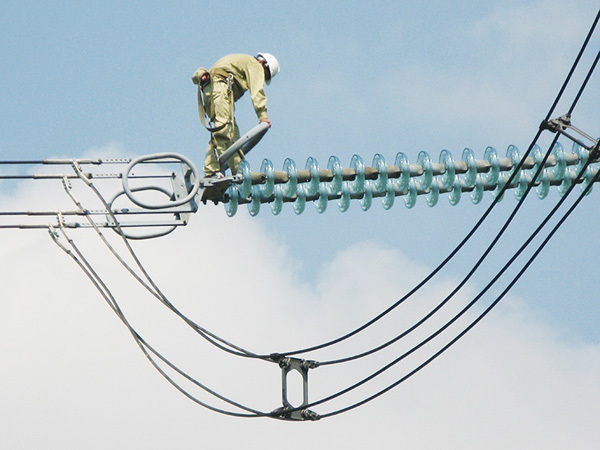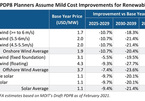The Ministry of Planning and Investment has pointed out a series of limitations within the newest draft of the National Power Development Plan VII, asking the Ministry of Industry and Trade to supplement missing content and adjust existing calculations.
 |
On October 3, the draft of the National Power Development Plan VII (PDP8) for 2021-2030, with a vision to 2045, was approved by the appraisal council after the Ministry of Industry and Trade (MoIT) consulted relevant ministries, despite previous reservations by the Ministry of Planning and Investment (MPI).
In September, the MPI issued a document signed by Deputy Minister Vo Thanh Thong, giving comments to the MoIT on the draft PDP8 and specifying the limitations that need to be remedied in the draft. However, none of these limitations have been tackled so far.
Among the issues is the draft’s inconsistency with the Politburo’s Resolution No.55-NQ/TW enacted in February 2020 on the orientation of the National Energy Development Strategy of Vietnam to 2030. The PDP8 proposes two options to design the power system. Within the base scenario, total installed capacity of the electricity system would amount to a little over 130,000MW, while the high-load scenario plans with nearly 144,000MW.
But according to Resolution 55, the total installed capacity should only reach 125,000-130,000MW by 2030. Thus, the current calculations in the PDP8 are exceeding the target set out in the resolution.
Power imbalance
According to the MPI, both load options propose to develop multiple liquefied natural gas (LNG) sources, leading to an increase in costs, while there is no alternative to exploit gas-fired power projects using gas from the Ken Bau gas field, which is located north of the coast of the central city of Danang.
Although the total gas reserves remain unclear, it is estimated that the Ken Bau field can be utilised for around 4,000-6,000MW in the central region. The MPI proposed to add calculations for base and high-load scenarios in case it is possible to exploit the sources of the Ken Bau field and thereby replace LNG usage in these areas to avoid a passive stand and reduce imports of LNG, which are prone to price fluctuations.
Regarding the total capacity of renewable energy sources developed in the next five years, the MPI confirmed that there is an imbalance between wind and solar power, with the former representation in the PDP8 thrice as high as the latter.
Meanwhile, plans for coal-fired power plants are not congruent with the goal of reducing its proportion in the system. Coal-fired power capacity in 2025 will account for up to 28.7 per cent, and even increase to up to 31.2 per cent in 2030.
However, the north of Vietnam is short of power and has no backup during peak periods. Moreover, the growth rate of the north’s power sources in the next 10 years is estimated to be slower than actual demand. Based on the current capacity of the system, the MPI has asked for a review of the list of sources developed in each period to ensure consistency between demand and supply.
In a far-reaching example of inconsistency, according to an MoU between Vietnam and Laos from 2016, the two sides agreed that Laos can sell at least 5,000MW to Vietnam until 2030. As per Resolution 55, it is necessary to increase these imports from neighbouring countries. Thus, the PDP8’s current base model, which only considers importing 3,900MW, is not consistent with the MoU between Vietnam and Laos.
Power source development in recent years has been at odds with load distribution, and many coal-fired power plants expected to operate in the last five years are behind schedule. The MPI thus proposed that the MoIT supplements the progress of these projects and increase the capacity of selected investors.
The MPI pointed out that, although the installed capacity of the whole system is already 1.8 times higher than the maximum load, there has not been an analysis of the suitability or inadequacy of the power source development.
Comprehensive evaluation
Renewable energy sources have a large installed capacity of about 17,300MW, accounting for 25 per cent of the whole system, but the generated electricity only provides about 4.63 per cent of input power to the whole system. The development of grid sources is the main reason behind this discrepancy.
The development of the power grid has not kept pace with the development of power sources, leading to congestion on the transmission grid and capacity cuts of renewable energy sources, which wastes resources.
Therefore, in order to ensure a comprehensive assessment of the current status of power grid development, the MPI proposed to the MoIT that the current difficulties in the operation of the power grid system must be dealt with, especially since renewable energies are developing rapidly.
Investment capital demand for the PDP8 is about $9.9-11.6 billion per year for the next decade, and another $12-15.2 billion a year for the 2031-2045 period. However, capital mobilisation has so far been slow and difficult.
Most credit institutions present many technical barriers on environmental protection when lending for power projects. Even China has announced that it will not build new thermal power projects abroad.
In the draft PDP8, the MoIT uses a socioeconomic scenario with a GDP growth rate of about 6.6 per cent per year in the next decade. This, according to the MPI, is not consistent with the 10-year socioeconomic development strategy, in which the average GDP growth rate is about 7 per cent per annum. Thus, the MPI asked for clarification on the reasons for choosing that value.
The MPI also pointed out shortcomings in implementation of the PDP8, particularly in sector management, inspection, and supervision. Thus, the ministry recommended that the MoIT supplements these contents before submitting the draft to the government.
Source: VIR

Vietnam to minimise new coal-fired power plants
Although the most recent draft of the National Power Development Plan increased the volume of coal-fired projects in Vietnam, the Ministry of Industry and Trade has said it won't consider developing any new coal-fired plants, to save the environment.

PDP8 delay to unlock more cost-effective renewables
The past 12 months have been a period of intense activity for Vietnam’s power sector.